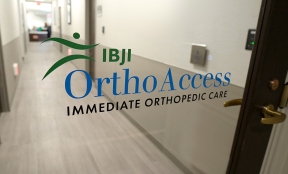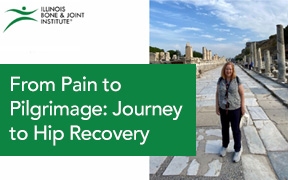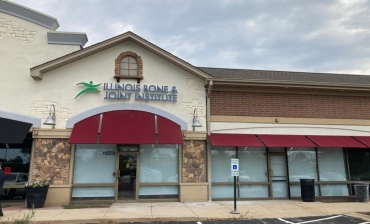This blog post was updated in January 2021, and is part of the Ultimate Guide to Hip Pain Relief.
Without a fully functional hipbone, you would not be able to stand, walk, run or dance. So, when you suffer from chronic hip pain and certain day-to-day activities suddenly become troublesome, it can feel as if your entire life is being put on hold. Keep reading to learn more about common causes of hip pain and when to seek treatment from a specialist.
The ball-and-socket hip joint fits together in a way that allows for fluid, repeated motion and a fair amount of wear and tear. Whenever you use the hip (for example, by going for a run), a cushion of cartilage helps prevent friction as the hip bone moves in its socket. The hip joint isn’t indestructible. With age and use, the cartilage can wear down or become damaged. Muscles and tendons in the hip can get overused. The hip bone itself can be fractured during a fall or other injury. All of the above can cause hip pain.
Symptoms of Hip Pain
Depending on the condition that’s causing your hip pain, you might feel the discomfort in your:
- Thigh
- Inside or outside of the hip joint
- Groin
- Buttocks
Sometimes pain from other areas of the body, such as the back or groin can radiate to the hip. You might notice that your pain gets worse with activity, especially if it’s caused by arthritis. Along with the pain, you might have reduced range of motion. Some people develop a limp from persistent hip pain.

Common hip pain causes and when you should seek treatment.
Common Causes of Hip Pain
If your hips are sore, here is a rundown of some of the most common causes of hip pain. The first step to fighting your pain is figuring out its source.
1. Osteoarthritis
Osteoarthritis is one of the most frequent causes of hip pain. According to the Center for Disease Control (CDC), it affects around 27 million people every day. Due to age, trauma or other factors, the cartilage in the hip that cushions your joints start to break down causing the bones to rub together during any movement. The bone-on-bone action creates pain, stiffness, and loss of movement. If conservative treatments fail, hip replacement surgery is an option.
Learn More About the Symptoms of Osteoarthritis.
2. Trochanteric Bursitis
Trochanteric bursitis is an extremely common problem that causes inflammation of the bursa over the outside of the hip joint. Bursa is the fluid-filled sac that works to reduce friction and cushion the points between the bones, tendons, and muscles. Bursa is located throughout the body, including the hips. It causes degeneration of the soft tissues that surround the muscles and bones of the hip. Rest, ice and pain medications can help treat the condition.
See How Bursitis Affects Your Hip
3. Tendonitis
Tendons are a fibrous structure used to join the muscles to the bone. Tendonitis can occur in any of the tendons that surround the hip joint. When the tendons in the hip become inflamed, irritated or swollen, it can cause immense pain. The most frequently encountered tendonitis around the hip is iliotibial band (IT band) tendonitis. Tendinitis can be caused either by injury or overuse of the tendons. It also happens with age as the tendon loses their elasticity.
4. Osteonecrosis
Osteonecrosis is a condition that occurs when an inadequate amount of blood flow reaches the bone, the cells die and the bone may collapse. One of the most common places for osteonecrosis to occur is in the hip joint.
5. Snapping Hip Syndrome
Snapping hip syndrome is a word used to describe three distinct hip problems. The first is when the IT band snaps over the outside of the thigh. The second occurs when the deep hip flexor snaps over the front of the hip joint. Finally, tears of the cartilage, or labrum, around the hip socket can cause a snapping sensation.
Learn More About Snapping Hip Syndrome
6. Hip Labral Tear
The labrum is the cartilage that surrounds the hip joint. The purpose of the labrum is to hold the ball of the thighbone firmly in the hip’s socket. Trauma, repetitive motions, and hereditary conditions can all cause painful tears in the labrum. Hip labral tears are being recognized as a cause of pain and catching sensations in the joint. Often hip arthroscopy is a treatment option.
Check Out How a Labral Tear Affects Your Hip
7. Stress Fracture
Stress fractures of the hip are most common in athletes who participate in high-impact sports, such as long distance runners. Treatment usually is successful by avoiding the impact activities.
8. Muscle Strains
Strains of the muscles around the hip and pelvis can cause pain and spasm. The most common strains are groin pulls and hamstring strains.
9. Hip Fracture
Hip fractures are most common in elderly patients with osteoporosis. Treatment of broken hips requires surgery to either replace the broken portion or repairing with a metal plate and screws.
Learn More About Hip Fracture Recovery and Treatment
10. Dislocation
A blunt force trauma such as an automobile accident or sports injury can cause the hip joint to become dislocated, where the ends of the bones become forced from their normal position. Hip dislocation is a very painful injury that can immobilize your hip joint, making walking near impossible. If you believe that you have dislocated your hip, seek medical attention at once.
When to Seek Treatment?
Always consult your physician for personal medical advice, however here are common times to seek treatment for your hip pain:
- The hip pain came on suddenly.
- A fall or other injury triggered the hip pain.
- Your joint looks deformed or are bleeding.
- You heard a popping noise in the joint when you injured it.
- If you have hip pain at night or when you are resting.
- The pain is intense.
- You notice swelling, redness or warmth around the joint.
- You can’t put any weight on your hip.
- You can’t move your leg or hip.
There are many conditions that may cause hip pain. Some conditions are more serious than others and that’s why it’s important to not self-diagnose and seek treatment from a physician–especially if you have chronic pain that is altering your day-to-day activities.
Our experienced physicians have the solutions for your hip pain, no matter the cause. Find a hip specialist and make your appointment today and get on the path to recovery.





